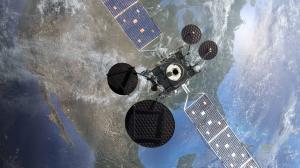Luminary Cloud and Northrop Grumman Launch Physics AI Model Powered by NVIDIA
Partnership showcases Physics AI successfully accelerating spacecraft system design and development from years to months
SAN MATEO, CA, UNITED STATES, October 28, 2025 /EINPresswire.com/ -- Luminary Cloud, the leading Physics AI platform, and Northrop Grumman Corporation (NYSE: NOC), a leading global aerospace and defense technology company, today announced a partnership introducing the world’s first Physics AI foundation model for spacecraft system design and development, powered by NVIDIA’s PhysicsNeMo framework. Physics AI enables government and commercial organizations to radically compress design cycles, unlocking mission-critical capabilities and delivering next-generation systems faster than ever before.The implications are profound. The Physics AI foundation model represents a major advancement in shrinking development timelines from years to months. By reducing development and testing risk in propulsion systems, Northrop Grumman can deliver spacecraft faster, with greater performance and more robust safety margins. That acceleration has the potential to transform the cadence of innovation in both space exploration and national defense.
“Physics AI is the next level of complexity in AI, and Northrop Grumman is bringing this technology to our design engineers to dramatically speed up hardware development,” said Han Park, vice president, artificial intelligence integration, Northrop Grumman Space Systems. “Using AI to make something small, like a spacecraft thruster, puts us on a path to do much bigger things, like using AI to design larger components or even an entire spacecraft.”
Historically, aerospace programs have relied on CPU-based Computational Fluid Dynamics (CFD) simulations to characterize aerodynamics and optimize propulsion subsystems—a process that can require months of compute time and budgets running into the millions. Northrop Grumman’s new foundation model reduces the analysis time for a single case from hours to seconds while preserving engineering-grade accuracy. This speed gives engineers the freedom to explore entire design spaces interactively and in real time.
The model demonstrates the capabilities of Luminary Cloud’s Physics AI platform, which unifies GPU-native simulation, large-scale dataset generation, and model training into a single “Physics AI Factory.” Using this platform, vast quantities of high-fidelity simulation data are generated, the model is trained, and the results are made accessible through a web-based application that enables engineers to evaluate performance on demand.
“AI Physics is opening new frontiers in engineering,” said Tim Costa, GM Industrial and Computational Engineering at NVIDIA. “By leveraging NVIDIA accelerated computing and our PhysicsNeMo framework, Northrop Grumman and Luminary are demonstrating how AI Physics models can redefine the pace and scale of spacecraft design.”
Luminary Cloud is expanding the possibilities for mission-critical productivity. The thruster nozzle AI foundation model offers transformational advantages to Northrop Grumman, including:
● Speed: Teams can leverage Physics AI models to accelerate project schedules and deliver customer outcomes months to years faster than current simulation technology.
● Scale: The model enables engineers to explore orders of magnitude more design candidates, allowing them to converge on higher-performing solutions.
● Accuracy: Trained on highly accurate physics simulation data to predict system performance with the precision required for spacecraft engineering.
“Collaborating with Northrop Grumman to advance the state of simulation technology for rocket propulsion is a meaningful opportunity for our team. This announcement signals more than just a technical achievement - it is an invitation to reimagine the very process of spacecraft design to be faster, smarter, and more adaptable,” said Juan Alonso, CTO of Luminary. “By combining our Physics AI know-how with Northrop Grumman’s deep engineering expertise, we’ve built a model that delivers speed, accuracy, and trustworthiness for use in design exploration workflows. We look forward to expanding this collaboration on future programs.”
As Physics AI models extend across propulsion and other subsystems, the industry will see traditional decade-long development cycles give way to an era of accelerated innovation from multiple sources, enabling humanity’s space ambitions to be realized on timelines once considered impossible.
For more information about this partnership, please visit: A New Structural Advantage: How Physics AI Is Transforming Spacecraft Design at Northrop Grumman and meet Luminary Cloud at NVIDIA GTC DC in Booth 417.
Jason Lim
Luminary Cloud, Inc.
Luminary@w2comm.com
Visit us on social media:
LinkedIn
YouTube
X
Legal Disclaimer:
EIN Presswire provides this news content "as is" without warranty of any kind. We do not accept any responsibility or liability for the accuracy, content, images, videos, licenses, completeness, legality, or reliability of the information contained in this article. If you have any complaints or copyright issues related to this article, kindly contact the author above.
